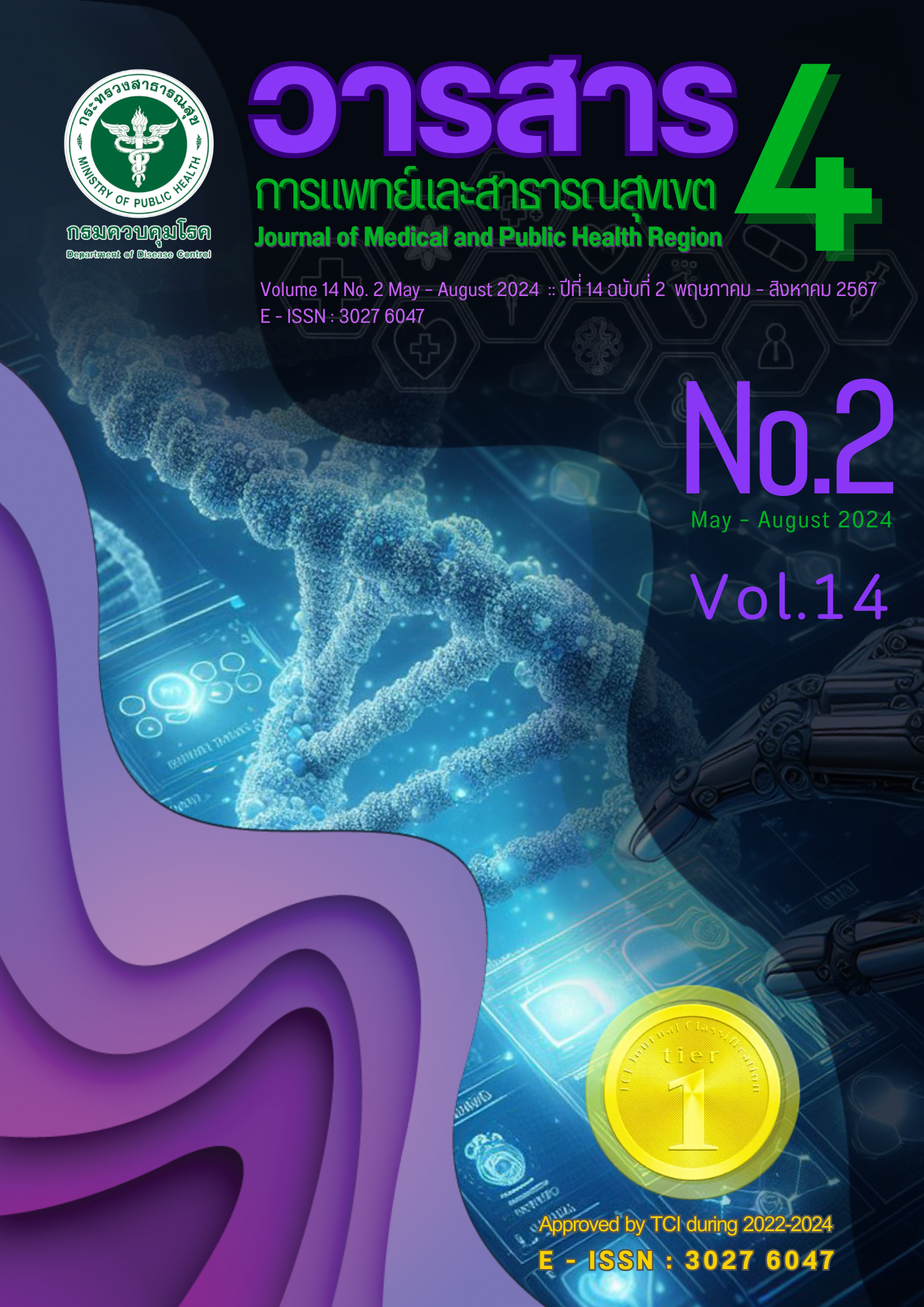Assessment of hemodialysis adequacy and associated factors related to hemodialysis adequacy in end - stage renal disease patients
Main Article Content
Abstract
Patients with end stage renal disease receiving hemodialysis have increased risk of morbidity and mortality from inadequate hemodialysis. This study aims to access the adequacy of hemodialysis and to study factors related to hemodialysis adequacy in patients with end stage renal disease. This study was performed as a retrospective cohort study in end stage renal disease patients undergoing hemodialysis at 2 hemodialysis centers in Langsuan between 1 July and 30 September 2022. Data were analyzed to access adequacy and associated factors related to hemodialysis adequacy using multivariate logistic regression analysis. One hundred and eighty patients were enrolled in the study. Patients achieved hemodialysis adequacy for 76% of Kt/V and 77% of URR, mean Kt/V 1.73 ± 0.53 and mean URR 73.28 ± 12.36.There were four factors significantly related to adequacy of hemodialysis: female adjust OR = 4.41, 95% CI 1.89 – 10.28, p = 0.001, dialyzer surface area of 2.1m2 adjust OR = 3.32, 95% CI 1.28 - 8.59, p = 0.013, blood flow rate 350 ml/min adjust OR = 4.39, 95% CI 1.79 - 10.76, p = 0.001, dialysis frequency 3 times per week adjust OR = 4.32, 95% CI 1.71 - 10.93, p = 0.002. There were four factors significantly related to hemodialysis adequacy including female, dialyzer surface area of 2.1m2, blood flow rate 350 ml/min, dialysis frequency 3 times per week
Article Details

This work is licensed under a Creative Commons Attribution-NonCommercial-NoDerivatives 4.0 International License.
References
Chuasuwan A., Lumpaopong A. Annual Report Thailand Renal Replacement Therapy 2007 – 2020 [Internet]. [cited 2023 Mar 18]. Available from: https://www.nephrothai.org/annual–report–thailand–renal–replacement–therapy–2007–2019–th/ (in Thai)
Daugirdas JT, Depner TA, Inrig J, Mehrotra R, Rocco MV, Suri RS, et al. KDOQI Clinical Practice Guideline for Hemodialysis Adequacy: 2015 Update. Am J Kidney Dis. 2015 Nov; 66(5): 884 – 930.
Bello AK, Okpechi IG, Osman MA, Cho Y, Htay H, Jha V, et al. Epidemiology of haemodialysis outcomes. Nat Rev Nephrol. 2022 Jun;18(6):378 – 95.
Lowrie EG, Laird NM, Parker TF, Sargent JA. Effect of the Hemodialysis Prescription on Patient Morbidity: Report from the National Cooperative Dialysis Study. N Engl J Med. 1981 Nov 12; 305(20): 1176 – 81.
Liu SX, Wang ZH, Zhang S, Xiao J, You LL, Zhang Y, et al. The association between dose of hemodialysis and pati ents mortality in a prospective cohort study. Sci Rep. 2022 Aug 12; 12(1): 13708.
Daugirdas JT. Kt/V (and especially its modifications) remains a useful measure of hemodialysis dose. Kidney Int. 2015 Sep;88(3):466 – 73.
Ahemd A, Azat NFA, Ali S. Assessment of Dialysis Adequacy Using Urea Reduction Ratio and KT/V in four Pediatric Hemodialysis Centers in Baghdad. Iraqi Postgrad Med J. 2015 Jan;14(4).
Rezaiee O, Shahgholian N, Shahidi S. Assessment of hemodialysis adequacy and its relationship with individual and personal factors. Iran J Nurs Midwifery Res. 2016; 21(6): 577 – 82.
AlSahow A, Muenz D, Al – Ghonaim MA, Al Salmi I, Hassan M, Al Aradi AH, et al. Kt/V: achievement, predictors and relationship to mortality in hemodialysis patients in the Gulf Cooperation Council countries: results from DOPPS (2012 – 18). Clin Kidney J 2021; 14(3): 820 – 30.
Eknoyan G, Beck GJ, Cheung AK, Daugirdas JT, Greene T, Kusek JW, et al. Effect of Dialysis Dose and Membrane Flux in Maintenance Hemodialysis. N Engl J Med 2002; 347(25): 2010 – 9.
Watanabe Y, Kawanishi H, Suzuki K, Nakai S, Tsuchida K, Tabei K, et al. Japanese society for dialysis therapy clinical guideline for “Maintenance hemodialysis: hemodialysis prescriptions.” Ther Apher Dial Off Peer – Rev J Int Soc Apher Jpn Soc Apher Jpn Soc Dial Ther. 2015;19 Suppl 1: 67 – 92.
Tattersall J, Martin–Malo A, Pedrini L, Basci A, Canaud B, Fouque D, et al. EBPG guideline on dialysis strategies. Nephrol Dial Transplant. 2007; 22(suppl_2): ii5 – 21.
Jindal K, Chan CT, Deziel C, Hirsch D, Soroka SD, Tonelli M, et al. Hemodialysis clinical practice guidelines for the Canadian Society of Nephrology. J Am Soc Nephrol JASN 2006;17(3 Suppl 1): S1 – 27.
Somji SS, Ruggajo P, Moledina S. Adequacy of Hemodialysis and Its Associated Factors among Patients Undergoing Chronic Hemodialysis in Dar es Salaam, Tanzania. Int J Nephrol 2020; 2020:9863065.
Chowdhury N, Islam F, Zafreen F, Begum B, Sultana N, Perveen S, et al. Effect of Surface Area of Dialyzer Membrane on The Adequacy of Haemodialysis. J Armed Forces Med Coll Bangladesh 2012;16: 7.
Panagoutsos SA, Yannatos EV, Passadakis PS, Thodis ED, Galtsidopoulos OG, Vargemezis VA. The Clinical Impact of Increasing the Hemodialysis Dose. Hemodial Int Int Symp Home Hemodial. 2001; 5(1): 51 – 4.
Vadakedath S, Kandi V. Dialysis: A Review of the Mechanisms Underlying Complications in the Management of Chronic Renal Failure. Cureus. 2017; 9(8): e1603.
Abdulla J, Shakor J, Shallal A. The effect of blood flow rates on dialysis adequacy and complications in both low and high flux membrane. 2020; 1039 – 43.
El–Sheikh M, El–Ghazaly G. Assessment of hemo-dialysis adequacy in patients with chronic kidney disease in the hemodialysis unit at Tanta University Hospital in Egypt. Indian J Nephrol 2016; 26(6): 398 – 404.
Elsharif ME, ahmed ME, M O, Gabar A, Miskeen E. Hemodialysis, plea of availability versus adequacy Gezira experience. Sudan J Public Health 2009; 4: 7 – 10.
Locatelli F, Buoncristiani U, Canaud B, Köhler H, Petitclerc T, Zucchelli P. Dialysis dose and frequency. Nephrol Dial Transplant Off Publ Eur Dial Transpl Assoc–Eur Ren Assoc. 2005; 20(2): 285 – 96.


